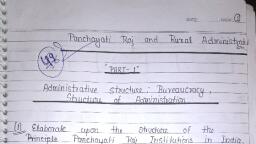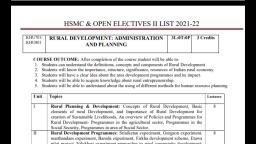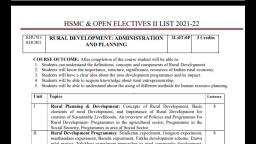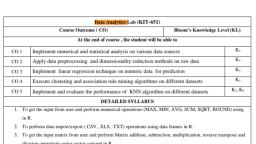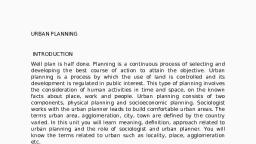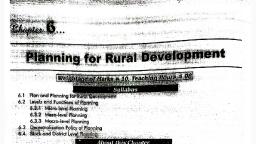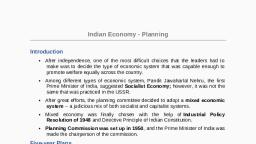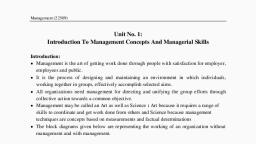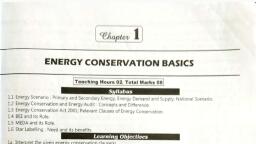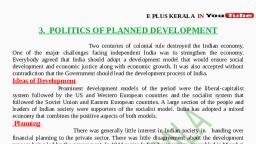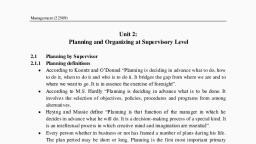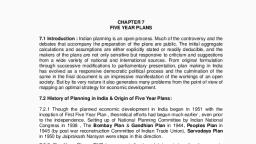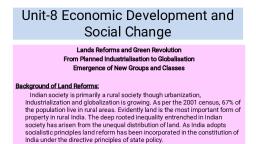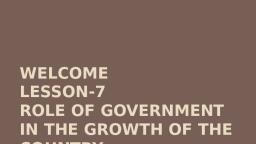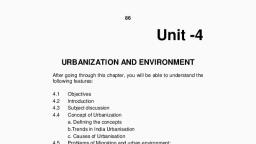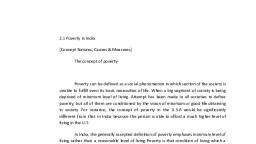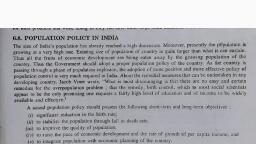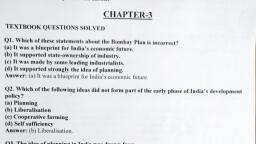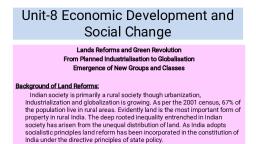Page 1 :
UNIT 1 PLANNING FOR RURAL, DEVELOPMENT, , Planning for, Rural Development, , Contents, 1.0, , Objectives, , 1.1, , Introduction, , 1.2, , Need for Planning, , 1.3, , Theories and Techniques of Planning, , 1.4, , Development Programmes and Projects, , 1.5, , Notion of Resources, , 1.6, , Rural Development Planning in India: A Brief Retrospective, , 1.7, , Let Us Sum Up, , 1.8, , Key Words, , 1.9, , Suggested Readings, , 1.0 OBJECTIVES, The purpose of this unit is to provide you with an understanding of the concepts, of planning and planning approaches for rural development. It aims at encouraging, you to ask questions about planning. After reading this unit, you should be able to:, l, , identify the role of planning;, , l, , elaborate some of the development planning theories;, , l, , explain the meaning of projects and project cycles;, , l, , discuss the concept of resources, and, , l, , give the evolution and development of planning experience in India., , 1.1 INTRODUCTION, You have learnt about the concepts, strategies and performance of rural development, programmes in the preceding two courses. The planning process was not discussed, there, so that your attention remained focused on the practical aspects of various, programmes., Rural development planning has gained prominence in recent times because of the, growing realization that benefits from development have, by and large, bypassed, large segments of rural society. At the same time, it has been recognized that the, organisation and structure of the process of planning have to be modified, so that, policies and programmes reflect the development needs of rural areas., In this unit, we give the overview of rural development planning. In the unit, which, follows, we discuss the process of rural development planning in India, while in the, subsequent units, the planning structure at different levels are considered., , 5
Page 2 :
Rural Development, Planning, , 1.2 NEED FOR PLANNING, Planning is the process of preparing a blueprint of actions to attain stated objectives, within a time frame. The determination of objectives, the specification of targets,, the strategy for mobilization of resources, the allocation of resources to different, development sectors, the blueprint of actions (including their operationalisation in the, shape of policies, programmes and their delivery system) are aspects, which have, to be considered in any planning exercise., Planning is essential because it enables us to formulate, with some precision, what, we intend to achieve within a given time frame. Prioritization among various, objectives enables us to demarcate more important objectives from those, which are, less so. Once this is done, one can decide what is feasible, considering the resources, at hand and how additional resources can be mobilized. Therefore, planning is a, more scientific path towards achieving development objectives, and for bringing, about economic and social transformation in a systematic manner., Perhaps, the most important reason, which comes to your mind, may be that you, are faced with a severe shortage of certain resources/factors. Given the fact that, each of these resources may also have different uses, you may be unable to decide, how to utilize these resources. It is in such a situation that planning becomes, extremely important. Therefore, you must plan the use of resources in some rational, manner., A logical question, which you must then reflect upon is: What is a rational manner?, Or, what are the resources available? Let us further illustrate the first question, before answering it. Suppose the objective is to plan the utilization of unskilled, landless labour in a community development block, so that people are able to get, gainful employment. Naturally, you would now start asking for information, such, as how many are employed by landowners for agricultural operations, which, agricultural operations are performed at various point of time? What would be the, prevalent wage rate, which schemes employing rural labour are being run by the, government department, how useful would be the works in which labour are employed, from the point of view of creating durable community assets and so on. From the, point of view of providing solutions, some of these alternatives may be more rational, or more desirable or feasible. Choice of alternatives, thus, may narrow down to, such preferable alternatives. The manner of arriving at this choice is to know the, decision criteria – an important component of planning process at any level., Most of the other justifications for planning can be broadly grouped into two–, growth and distributive justice. Growth, here, would mean an increase in output per, unit of time, given the level of resource use. The growth in output is conditioned, by the quality and quantity of resources. Distributive justice means that, as growth, takes places in a society, the gains from increased prosperity are distributed in a, more egalitarian manner across various classes and groups in that society. This, would, for instance, cover policies, which aim at income distribution to reduce, income inequalities among classes and regions, asset distribution to reduce inequality, in terms of ownership of asset, alleviation of poverty, and improvement in quality, of life through better access and utilization of social services., , The Need for Planning in India, , 6, , An underdeveloped economy like India is characterized by inequalities of incomes, and ownership of assets. The high incidence of rural poverty, coupled with these, inequalities, makes the task of rural development particularly important. There are
Page 3 :
also regional imbalances and problems connected with the development of areas,, which are disadvantaged due to geographical and ecological factors (as for example,, drought-prone areas, flood-prone areas, etc.). Needless to say, planning in India, has to be geared to meet these challenges., , Planning for, Rural Development, , You will appreciate that it is the people who are the focus of development and, the poor should be given priority because their numbers are large and they are the, most vulnerable. In India, vast numbers of the rural poor have limited access to, social services and these are reflected in low rates of literacy, high incidences of, infant and child morbidity and mortality, poor health and nutrition status, poor, environmental sanitation and hygiene, limited access to potable water and poor, housing. The central approach to any development process has to be one of enabling, the poor and other disadvantaged people to improve their situation, both social and, economic., , Check Your Progress I, Notes: a) Use the space provided below for your answers., b) Compare your answers with the text., 1) Justify, in your own words, the need for planning., …………………....................………………………………………...., ….…...………..…………………………………………..…………….., …...………………….......……………………………………………...., ............……..……………………………………………..…………….., 2) How can planning reduce regional disparities?, …………………....................………………………………………...., ….…...………..…………………………………………..…………….., …...………………….......……………………………………………...., ............……..……………………………………………..…………….., , 1.3 THEORIES AND TECHNIQUES OF PLANNING, There are several theories of development planning that have been put forward, during the last few decades. They are suited to particular situations prevailing in, some countries. They cannot be applied uniformly in all situations. It is important, that you understand this. Many approaches to development are being evolved and, tried and a number of alternative theories have been put forth. Since the main, objective of planning in the initial stages was growth, the main attention was, focused on ‘Modelling’ the production structure of the economy and identifying the, factors limiting its expansion. These theories are readily applied to most of the, developing countries in which the industrial sector has a predominant share in the, total output., As the concept of distribution (social justice) came to be recognized as an important, objective, the growth planning models started including a set of disaggregated regions, or spatial areas in their framework. Thus, multi-sectoral models have been proposed, to include factors affecting the income levels of different groups. The development, during the sixties and seventies paved the way for theories of regional development, planning., , 7
Page 4 :
Rural Development, Planning, , Theories of Regional Development Planning, The earlier approaches to regional development, evolved in the industrially developed, western countries, were mainly growth oriented and presumed that higher growth, rate could be achieved through modern sectors’ activities. However, the concept of, generating higher growth in regional economy varied in different development theories, or models. The various types of regional development theories with their implications, for rural regional planning are shown in Table 1.1. Some of the relevant development, theories are mentioned in the table. You may refer to Section 1.8 (Key Words) in, order to understand the meaning of some terms, which you may not be acquainted, with. Further, if you would like to read more on some of these theories, there are, several books available. You may, for instance, refer to Michael P. Todaro’s Economic, Development in the Third World (1985) or to Subrata Ghatak’s An Introduction to, Development Economics (1986)., , Table 1.1, Theory, , Associated Policy/Planning Models/, approaches, , 1), , Economics Base Multiplier Theory, , Economic base Models (Multiplier analysis), , 2), , Macro-economic Growth Theories, , i), ii), , 3), , Polarised Development (Diffusion, Theory; Central Place Theory;, Propulsive Firm Concepts), , Growth pole centre strategies:, i) Intermediate size cities as countermagnets, to primate cities., ii) Lower order population centres as foci for, development from below., , 4), , Modernisation/Neo-classical and, Marxist Stage Theories, , i) Accelerated urban base., ii) Two-sector growth models., iii) Large-scale capital intensive resource, based projects, , 5), , Agriculture/Land use Theories, , Von Thunen models; Agricultural land use, zoning or regionalisation with locational, advantages., , Input-Output Models., Tinbergen Planning Model/incremental, capital output ratios for sectors/industries., , The basic principle in these theories, as presented in rows 2, 3 and 4, is that growth, does not take place everywhere at the same time. Since factors that affect growth, have varying intensities, it manifests itself at some points of the economy or in, certain regions called ‘poles’, and then spreads to other sectors and areas through, different channels. Also, there are variations in the impact of such growth on the, economy as a whole. Growth in a regional economy, thus, can be induced through, modern sector activities or by diffusing the process of development through growth, ‘poles’. The “economic base theory”, while recognizing the role of local resources, in the regional economy, emphasized that higher growth can be achieved by expansion, of either primary or manufacturing activities to produce goods for export., , 8, , The regional development approach, adopted in the developing countries, was derived, mainly from the models discussed above. Developing countries are characterized by
Page 5 :
a high degree of regional imbalances, income inequalities and an agrarian economy, with low rates of growth and high unemployment and under-employment. So, such, countries have reconstructed these growth models in such a way that they would, help in achieving the twin objectives of development, viz., economic growth and, distributive justice., , Planning for, Rural Development, , Rural Development Planning Methodologies, There has been considerable work in evolving methodologies for micro-level planning, in India in recent years, particularly after the Fourth Five Year Plan. The Planning, Commission emphasized the formulation of district plans, provided guidelines for, district planning and suggested:, “The first objective of the formulation of district plans is to set forth a long-term, perspective indicating the economic activities to be established in different subregions of the district and the measures to be taken over the next 15 to 20 years, to develop (and conserve) natural resources, build up infrastructural facilities and, social services and foster the growth of towns and cities in a manner that would, help the district to develop in the predetermined direction. The second objective is, to prepare an integrated programme of action for the next conditions and a realistic, assessment of the immediate problems, short-term priorities and available resources”., From the above statement, it is clear that in the beginning, the approach to development, was regional with emphasis on growth points and location of economic activities., Over the years, there have been shifts in the national policy for rural development, to achieve growth with distributive justice by minimizing income inequalities between, various sections of society and growth disparities between areas and regions. To, achieve these objectives, area approach and target group approach were added in, the framework. Based on the progressive changes in the approach, the methodologies, evolved for rural development planning can be described under three categories –, Growth Centre Approach, Area Development Approach and Integrated Development, Approach., , Growth Centre Approach, The basic logic behind this approach is that development in rural areas can be, fostered by interesting resource mobility towards these areas for the generation of, infrastructural facilities. The constraints, in this regard, arise because of two main, reasons. Firstly, there are financial constraints. Secondly, economic efficiency of, investment has to be ensured. This means that facilities should be located at, appropriate places. Some villages have smaller population that are not sufficient for, proper and full utilization of investment. Location of facilities have to keep in view, the minimum threshold population., The concept of rural growth centre is to identify ideal locations for investment and, also act as a focus for inducing growth in the area concerned. The main foundation, of this approach was provided by Location Theories and the Central Place Theory., Location theories emphasize the importance of spatial factors in development. Thus,, the provision of economic and infrastructural facilities in certain locations can generate, growth in the areas adjoining these centres. The central place theories focus attention, on growth centres, which generate growth in areas around them. However, the, concept ignores the potentiality of local economic forces that may induce growth., Emphasis on dynamic local factors may be more impracticable under rural Indian, conditions. The other problem is that the growth centres do not take into consideration, the future trends of repolarisation of socio-economic activities taking place in an, area., , 9
Page 6 :
Rural Development, Planning, , Area Development Approach, This approach is an extension of the growth centre approach and takes into account, the local factors in achieving economic growth. Then, integrated development of an, area depends not only on the development of an adequate infrastructural network, but also on the way factors of the local economy are activated around the production, infrastructure. In other words, for integrated development of an area, spatial and, functional integration is necessary. Thus, while rural growth centres provide ideal, locations for the provision of infrastructural facilities, their hinterlands are regarded, as basic planning units for integrated multi-sectoral planning to achieve integrated, development of an area. This approach, therefore, was able to provide a wider, framework for rural development. The approach, while taking poverty in the area, into consideration, provides a balance between various sectoral activities as well, as spatial patterns of growth. However, it does not ensure that economic growth, is being shared by all classes and communities of the rural areas. The spread effect, of development may not necessarily affect the whole society in the same way or, with greater equality, particularly in Indian rural situation because of two reasons:, l, , In the areas where modern farm technology has not been able to make an advance,, agriculture and its allied activities cannot absorb fully the labour available in villages;, and, , l, , A sizeable number of rural people have little or no access to resources, particularly, land., , Integrated Rural Development Approach, In the context of problems in the area development approach, as discussed above,, and the government policy to tackle the problem of rural poverty, a new strategy, of rural development, i.e. the integrated rural development approach, has been, developed because the area development approach, by and large, failed to address, the question of inequalities in the distribution of employment, incomes and assets., A mere geographical emphasis, as is the case with the area development approach,, has been found to be inadequate in solving the problems. Target groups have to be, identified for a more direct approach to alleviate the problems faced by specific, sections of the population having specific identifiable problems., The draft Sixth Plan (1978-83) indicated the concept of integrated rural development, in the following words:, “Experience of various rural development programmes in the earlier plans has, shown that a mere project approach or a sectoral approach is not adequate to lead, to an overall development of the area and distribution of benefit to local population,, particularly the weaker section of the society. The distribution of unemployment and, poverty and the potential for development of agriculture and related activities vary, widely from region to region and also within regions. It will, therefore, be necessary, to plan for integration of various programmes and establish appropriate linkages for, optional utilization of local endowments, consistent with the plan objectives, local, needs and environmental balance., , 10, , The integrated rural development, now envisaged, will be specially focused on the, target group comprising small marginal farmers, agricultural labourers and rural, artisans, whose economic improvement is an important concern of rural development., The new approach will aim at integrating field programmes reflecting the economic, activity of the rural family whose employment and development is the basic objective.
Page 7 :
It is proposed to bring this about by developing the primary secondary and the, tertiary sectors. A major effort will be made to formulate area specific plans at the, grass root level”., , Planning for, Rural Development, , Check Your Progress II, Notes: a) Use the space provided below for your answer., b) Compare your answer with the text., Explain and contrast Growth Centre Approach and the Area Development, Approach., ..........…………………….......……………………………………………...., ..........……...…………………………………………………..…………….., ..........…………………….......……………………………………………...., ..........……...…………………………………………………..…………….., ..........…………………….......……………………………………………...., ..........……...…………………………………………………..…………….., , 1.4 DEVELOPMENT PROGRAMMES AND, PROJECTS, Rural development programmes, planned and executed during the last four decades,, can be grouped under two heads:, l, , area-based programmes, and, , l, , target-group oriented programmes., , Intensive Agriculture District Programme (IADP), Drought Prone Area Programme, (DPAP), Command Area Development Programme (CADP), and Desert, Development Programme (DDP) are some of the area-based programmes. Targetgroup oriented programmes, such as the Integrated Rural Development Programme, (IRDP), are meant for the upliftment of specific sections of the rural society., Every programme, whether area based or target group oriented, is made up of, a set of development projects. For example, Command Area Development includes, on-farm development project, project for the creation of infrastructural facilities,, canal modernization project, and so on. Sets of projects make up a development, programme; therefore, development projects can be called the building blocks of a, development programme., Let us examine the meaning of a development project. Every project requires, different types of resources, such as material, manpower, machinery, and finance., A development project is a time bound task to achieve specifically stated objectives, with investment of resources. It, in contrast to a scheme, is a very specific activity, in a specific area to achieve specific results within a specified time frame., , Advantages and Disadvantages of Development Projects, Let us first discuss the advantages. The Development projects, l, , concentrate resources on select priorities., , l, , focus on specific geographic areas., , 11
Page 8 :
Rural Development, Planning, , l, , address specific population groups and constraints on development., , l, , function as intensive social laboratories using an innovative approach, a limited, scale to gain experience for larger scale efforts., , Some of the disadvantages are listed below. They, l, , function as segmented units of intervention., , l, , bypass overall structures., , l, , develop atypically., , l, , create enclaves., , l, , siphon resources away from parallel non-project activities., , l, , cannot always generate sustainable development., , l, , often overlook socio-structural and institutional variables., , Project Cycles, The project, from conception to operationalisation, passes through various stages in, a cyclical fashion. These stages constitute the project life-cycle., First, a project idea is floated. Who floats the project idea? It may be the department, concerned, the village assembly, block level bodies, the target groups, voluntary, bodies engaged in development work, scientific and technical research groups, or, the central planning agency., Subsequently, the floated idea has to be tested for its worthiness before preparing, a blueprint. A sound judgment based upon experience and available knowledge of, the local conditions can be the only guide to this decision. However, once a project, idea has been identified and accepted, work on the preparation of its blueprint has, to begin in the department concerned. A continuous interaction and feedback among, team members is very necessary for successful completion of the task., With the completion of the blueprint, if the project is found admissible, it goes for, election, along with other projects of the sector. Further, if it is selected, it is, monitored, and finally, the results need to be evaluated., The following Chart illustrates the project life-cycle:, Chart I: Project Life-cycle, Pre-Plan Period, Conception, or, Identification, , Technical, feasibility, , Economic, worthiness, , Financial, viability, , Selection, , (1), , (2), , (3), , (4), , (5), , Plan Period, , Post-Plan Period, , Construction, , Operation, , (6), , (7), , Project Working life, , 12, , Ex-ante Evaluation, , Concurrent, Evaluation, , Ex-post, Evaluation
Page 9 :
The chart indicates different time phases of a life-cycle, the position of the phases, with reference to the plan period and the kind of decision problems to be solved, at different phases follow the sequence shown in the chart. Although each phase, has its own specific problems of decision, the overall problem of the pre-plan, period is to decide whether the project is worthy of selection for inclusion in the, plan. The problems of construction phase are of different nature, where management, techniques when applied, help to answer questions like how to organise work within, a time schedule, so that a smooth flow of materials and labour to the project is, maintained. This also helps the managerial staff in achieving maximum efficiency, in construction and operation of the project., , Planning for, Rural Development, , 1.5 NOTION OF RESOURCES, In any developing country, the major problem is always of resources. Essentially,, these are of three types–women, money and materials. Financial resources can be, mobilised within the country through tax efforts and market borrowings, etc., and, from external sources through exports, remittances, borrowings and aid loans., Planners have to ensure a match between these sources. With these resources, the, planner has to consider completing demands and then accommodate as many of, them as possible, looking at the overall objectives set for the country., As regards the manpower required, this, again, has to be carefully planned and, necessary arrangements should be made for human resource development right, form the grass roots level upwards to the highest technical levels., The third aspect of resources is the materials required for enabling the development, process to take place. Planning has to provide for the availability of such resources, – for example, oil, steel, cement, power, fertilizer, etc., Therefore, while seeking to meet the demands of the people through the plan, the, planner has to ensure that the materials required for building up the infrastructure, and support are simultaneously planned for and provided., Let us briefly view the various dimensions of resources. Generally speaking, stock, and flow, mobility and immobility over space, quality variations or grades of resources,, and renewal ability are the dimensions we will take up for discussion., i), , Stock and Flow: A stock is the quantity of a resource existing at any point of, time. Agricultural and forest land, a herd of cattle, and agricultural implements, refer to a stock of respective resources existing at the time of counting, say, as on, March 31 of a particular year. Human use of resources means that there is a, drawing on the stock itself, as in the case of non-renewable resources like minerals,, or there is drawing of an output from the stock, as in the case of renewable, resources like fisheries, forestry, livestock, agricultural land or underground water, reservoirs., Any drawing on (i.e., slow release or use) the stock itself or of an output from the, stock is considered a flow. In other words, any drawing or use of a quantity of the, resource of the output from the resources during a period of time is called a flow., For example, conceptually, whereas agricultural land is a stock , the produce from, the land is a flow. Let us take another example. Consider a sum of money (say, Rs. 10,000) deposited in bank at the beginning of the year. This sum is a stock,, capital fund. If you need some money, say at the end of the year, you have two, , 13
Page 10 :
Rural Development, Planning, , options to exercise. Withdraw a part of the capital fund, stock or principal sum;, or withdraw part or whole of a year’s interest earned on the principal sum. If you, choose the first option, the money withdrawn is a flow out of stock, whereas,, when the second option is chosen, it is a flow out of output (interest earning). An, alternative illustration is your monthly income, which is a flow because it has, been earned over a period of one month. This means that a flow will always have, a time dimension like per day (e.g., wages), per month (salary), per year (interest)., A stock is always defined at a point of time (for example your bank balance, on any given day)., ii) Mobility in Space: Most natural resources have specific location because their, use by human beings has to be in places where they are found. Agricultural land,, fishing grounds, forests, pastures, mines, reservoirs and water streams are all, location specific, immobile resources. A few resources like livestock and human, labour are, however, mobile within the constraints of ecological and social factors., Most man-made capital resources, especially manufactured means of production,, are more mobile over space. From the angle of development planning, a, classification of resources by their relative mobility is extremely desirable. A, fund of money or capital in value form is the most mobile resource., iii) Grades of Resources: Since output flow from a stock of resources tends to, decline with degradation in quality, an essential planning task is to preserve,, conserve and improve the quality of resources. Accordingly, a knowledge of, distribution of resources by quality and grade becomes a primary requirement, for any planning agency. Therefore, an essential planning task at the appropriate, level is to prepare an account of stocks of resources existing in the base year, of a planning period. Such an account has to reflect on the characteristic, features of different types of resources discussed above. The account is so, designed as to provide answers to relevant questions of planning such as:, l, , What is the quantity of the stock of a specific resource?, , l, , What is the pattern of ownership, utilization or under-utilization?, , l, , What is the current flow of output?, , l, , What could be the attainable output, given the current status of science and, technology?, , l, , Is there a scope for increasing the quantity of stock?, , iv) Renewal: In our everyday life, a continuous flow out of non-renewable stock, (for example mineral mines, oil-well) means depletion of stock and its eventual, exhaustion. The process is irreversible. In the case of renewable stocks (pastures,, forests, cattle or livestock herd), in most cases, the process is reversible in the, sense that a period of depletion can be followed by a period of regeneration and, rebuilding of stock. However, there is always an upper limit to the flow. Therefore,, in some cases, the depletion is faster than the pace of regeneration. Over fishing,, overgrazing and felling of trees, illustrate precisely this phenomenon. Thus, there, is a maximum sustainable output level, determined by the biological and ecological, conditions of regeneration of resources concerned., , 14
Page 11 :
Check Your Progress III, , Planning for, Rural Development, , Notes: a) Use the space provided below for your answer., b) Compare your answer with the text., Explain and differentiate between the concept of stocks and flows., ………..........…………….......……………………………………………...., ..........……...…………………………………………………..…………….., ..........…………………….......……………………………………………...., ..........……...…………………………………………………..…………….., ..........…………………….......……………………………………………...., ..........……...…………………………………………………..…………….., , 1.6 RURAL DEVELOPMENT PLANNING IN INDIA:, A BRIEF RETROSPECTIVE, Even before 1947, the Indian National Congress indicated its commitment to planning, and prepared a set of reports, which generated a lot of interest and discussion., Apart from this, some prominent industrialists published in 1944 the document, A, Brief Memorandum Outlining a Plan of Economic Development for India., Much earlier in 1934, M. Visveswaraya had published a Ten Year Plan, aimed at, doubling the national income., Jawaharlal Nehru, the nation’s first Prime Minister, is generally regarded as the, architect of planning in India. He viewed planning as a way of developing the, country avoiding the unnecessary rigours of an industrial transition in so far as it, affected the lives of the masses living in India’s villages. Moreover, he recognized, that planning was a positive instrument for resolving imbalances and contradictions, in a large and heterogeneous country, such as India. The first three Five Year Plans, are generally regarded as the most lively phase in India’s planning exercise., , The Early Years of Planning, Though the First Five Year Plan (1950-55) was basically a simple exercise of, putting together programmes, targets and outlays, it provided the first milestone in, rural development through the launching of the Community Development Programme, and National Extension Service., India’s tryst with planning came with the formulation of the Second Five Year Plan., P.C. Mahalanobis, an eminent statistician, and a man with a wide range of ideas,, is generally credited with preparing the blueprint of the Second Plan. At that point, of time, this plan was the most self-conscious attempt at planning in any newly, independent country in the Third World. Almost all major contemporary economists,, who took an interest in the study of development economics, interacted with Indian, planners during these years – and so did several of today’s Nobel Laureates., The Second Plan (1955-60) laid a strong emphasis on industry. The idea was that, this strategy will relieve the excess population in rural India. The strategy sought, to increase employment in heavy industry and the capital goods sector, so that the, load on the agricultural sector could be lightened. It was primarily a strategy of, industrialization, which hoped to succeed by forging strong industry linkages, both, forward and backward. As a result of this emphasis, the performance of India’s, , 15
Page 12 :
Rural Development, Planning, , capital goods sector improved substantially during this period. It also laid a solid, ground for a vibrant and self-reliant industrial base in India., Though the Second Plan is widely regarded as an “industrial plan”, there were other, path-finding formulations made by Indian planners during this period, as well. For, example, the Plan document included a very lucid chapter titled “Land Reform and, Agrarian Reconstruction”. Emphasis and hopes were placed on cooperative farming, practices in Indian agriculture. The formulation also envisaged a vast network of, community development programmes, national extension services and an irrigation, network financed by public budgets. The concept of democratic decentralization for, assigning development responsibilities to Panchayati Raj institutions was also, advocated (by the Balwantrai Mehta Committee). Thus, while it would be inaccurate, and unfair to say that the Second Plan lacked an agricultural strategy, it would not, be unwarranted to maintain that planners were grossly over-optimistic as to what, traditional Indian agriculture, with its conventional input-output basis and deepseated social stratification, could do within the political constraints., , Role of Planning During the Years of Crises, Among the priorities listed in the Third Plan, it was generally recognized that, agriculture had the first place. Thus, in its initial formulation at least, the Third Plan, differed from the Second Plan. It is generally recognized that there was a general, de-emphasis of agriculture in the Second Plan. The Third Plan attempted to reverse, this., Indian planning suffered two major shocks caused by exogenous factors in the, 1960s. The first came in the shape of the war with China in 1962 and the second, in the form of successive harvest failures in 1965 and 1967. The first shock caused, a sharp increase in India’s defence outlays and a severe curtailment in public, investment of the government. Consequently, the capital goods sector was badly hit., The crises on the food front was met with wheat import from the USA. This, situation, for the first time, seriously exposed India’s dependence on international, aid. However, Indian planners woke up to the need to build food self-sufficiency, as a result of these crises. The response of the government to the crises came in, the shape of the abandonment of the Five Year Plans. As a result, the period, between 1966 and 1969 – the Annual Plans Phase – is often labelled as the ‘Plan, Holiday’ period., The Annual Plans were notable for the formulation of a clear-cut strategy of, agricultural development. This strategy carried over into the Fourth Plan and was, notable for its shift in perception of the binding constraints on Indian agriculture. It, had hitherto been maintained that a conservative rural social and economic structure,, coupled with inefficient agricultural practices, acted as major constraints on the, agricultural sector. Further, land reform had largely been avoided; in practice, however,, their need was felt as vital. On the other hand, the new strategy made a perceptible, shift from this perception of the problem of the agricultural sector. Instead,, technological modernization was felt to be the main problem. In other words, it, called for a strategy that would make it possible to “bet on the strong”., , Planning and Agricultural Transformation, The new strategy came to be implemented during the course of the Fourth Plan and, was more popularly known as the “Green Revolution” in agriculture., , 16, , Even as the “Green Revolution” in agriculture was ushered, it was realized that, “distributive justice” still remained a distant dream. Thus arrived the popular slogan, of Garibi Hatao (Remove Poverty) and with it came the emphasis on poverty
Page 13 :
alleviation as a distinct planning objective in its own right. In fact, a document, prepared by the Planning Commission, though never officially published, for the first, time put the problem of poverty eradication in the forefront of political and public, discussion., , Planning for, Rural Development, , The Approach Paper to the Fifth Plan followed the recommendation of Working, Group in its definition of poverty in terms of nutritional inadequacy and ventured to, put the explicit redistribution of incomes towards the lowest three deciles as an, objective in itself. Thus, the basic approach of the Fifth Plan was growth with, redistribution. However, on account of the serious harvest failure of 1972-73 and, the oil crises of 1973, inflationary pressure forced Indian planners to seriously, curtail the ambitious programmes they had envisaged. Public investment continued, to be under strain and, as a result, many of the programmes had to be postponed, to the next Five Year Plan. The 1970s are significant because of the Minimum, Needs Programmes, IRDP, Rural Employment Programmes and some area, development programmes about which you have read in the previous courses., , Poverty Alleviation and Indian Planning, The Sixth Plan, (1980-85) again undertook eradication of poverty as its primary, aim. Consequently, the programmes to eradicate poverty – NREP, RLEGP (later, merged into Jawahar Rozgar Yojana). TRYSEM, DWCRA Integrated Rural, Development Programme – were strongly emphasized. The IRDP, coupled with, rural employment programmes, the Minimum Needs Programme and the area, development programmes, meant that the Sixth Plan had a strong emphasis on the, rural sector., Poverty alleviation continued to be a central concern in the Seventh Plan. Growth, of employment opportunities, human resource and infrastructure development, removal, of inequalities, an expanded system of food security, increase in productivity in, agriculture and industry, participation of people in development and substantial, improvement in agricultural and rural development administration, were identified as, priority areas. In the course of the Seventh Plan, the emphasis had shifted towards, the concept of modernization again – this time in industry. With this came the, relative de-emphasis on the public sector as an engine of growth. Modernization, and diversification of industry, adoption of new technology, a generally satisfactory, level of industrial performance (more so in some sectors), broad based, entrepreneurship development and growth of new industries like petro-chemicals, have also been considered as positive developments., A number of imbalances cropped up during the Plan Period. First, the massive, inflow of imports under the liberalization regime had meant an adverse movement, in India’s balance of payment position. During the plan period, the continuous strain, on the fiscal resources of the government was so severe that it generated inflationary, pressure despite the record levels of agricultural output. The decline in the ability, of India’s economy (the organised sector) to generate employment out of investments, was manifest during the Seventh Plan. As the Approach to the Eighth Plan 199095 pointed out, “The large reduction in the share of the agricultural sector in GDP, has been accompanied by only a marginal reduction in the proportion of people, dependent on this sector. Consequently, the agriculture non-agriculture disparities in, terms of output (and incomes) per head”., The Ninth Plan emphasized “priority to agriculture and rural development with a, view to generate adequate productive employment and eradication of poverty”., The Tenth Plan continued the three programme strategies of the Ninth Plan to, (i) increase farm productivity and growth of other activities in rural areas,, (ii) poverty alleviation progremmes, and (iii) public distribution system, especially, to those below the poverty line., , 17
Page 14 :
Rural Development, Planning, , The Tasks Ahead, It is widely recognized that India’s planning process has been one of the most, consistent among such efforts undertaken in the Third World. The Plan efforts have, contributed significantly in many fields, most notably in the increase in food production., However, a number of problems still remain., The desire for planning at multiple levels remains largely unrealized despite the, commitment made by successive governments. This contradiction has seriously, undermined the concept of making planning more democratic and responsive to, people’s aspirations. Further, regional inequalities and income inequalities persist in, India despite planned economic development. This is a serious problem, which if, uncorrected, can lead to more strain on the political fabric of the Indian state., Centre state relations, particularly in regard to planning functions and powers to, mobilize financial resources, have been under stress. These issues mean that, decentralization of the planning process has become an issue of top priority, which, if not seriously implemented, may well jeopardize the concept of planned economic, development itself., The problem of inequalities in the distribution of incomes and assets and low, productivity continuous to be a major problem facing Indian planners. As you may, recollect, we had focused attention on these aspects in the first Block of course 1., Tardy progress in land reforms and major institutional rigidities still hamper the, development of Indian society. The problem of the rural poor – particularly, the, landless and marginal farmers – still remains a major issue on the agenda of Indian, planning. Social services in rural areas continue to be at unsatisfactory levels. The, development of women, Scheduled Caste and Scheduled Tribes and other backward, classes are other areas of concern., , Check Your Progress IV, Notes: a) Use the space provided below for your answer., b) Compare your answer with the text., You have read how our planners viewed the “binding constraint” in agriculture, during different points in time. Explain briefly, in your own words, the, differences in perception., ........…………………….......……………………………………………...., ......……...…………………………………………………..…………….., ......…………………….......……………………………………………...., ......……...…………………………………………………..…………….., ......…………………….......……………………………………………...., ......……...…………………………………………………..…………….., , 1.7 LET US SUM UP, In this unit, you have learnt the importance of planning for developing countries., We saw how the goal of attainment of growth with social justice has to be specifically, incorporated into development planning if the social and economic transformation of, the country is to be brought about., 18, , * state with smaller ‘s’ refers to its meaning in the macro sense, as Indian state, while State with capital ‘S’ refers to the federal units as in the state of Maharashtra.
Page 15 :
We also read the different development theories and the various approaches to rural, development planning. You came to know about the growth centre approach, the, area development approach and the integrated rural development approach, You, were also briefly acquainted with the main features of development projects that, were introduced to the concept of project cycle., , Planning for, Rural Development, , Resource is an important factor in planning. We introduced you to the notion of, resource and the concept of stock and flow., We then went through a brief review of the planning exercise undertaken in India, since Independence. The main areas of emphasis in different decades were indicated., , 1.8 KEY WORDS, Concurrent Evaluation, , : On-going evaluation, while the project is under, implementation., , Decentralized Planning, , : Planning at several levels and not just at the apex, (i.e. the centre)., , Distributive Justice, , : Justice to ensure that gains from development reach, every section of society., , Economic Base, Multiplier, , : The term used for a form of regional multiplier,, which is able to estimate the impact of changes in, an area’s economic base on the economy as a whole., , Ex-ante Evaluation, , : Evaluation carried out prior to the actual or main, event occurring, i.e. before the actual project is, operational., , Ex-post Evaluation, , : Evaluation carried out after the event has taken, place, i.e. after the project (some phase or all) has, been implemented., , Flow, , : Output during a unit period of time., , Growth, , : Increase in output/number per unit of time., , Growth Pole Centre, , : Growth generated at nodal centres acting as poles, leading to accelerated growth in the region., , Input-Output Model, , : An economic model, which is based on the capacity, of inputs of each sector (of the economy) to, generate outputs. The quantity of outputs generated, by the use of inputs is represented by the inputoutput ratio., , Incremental Capital, Output Ratio, , : The amount of capital that results in output increasing, by one unit., , Multiplier, , : An economic term, which means that any investment, undertaken in an economy normally causes incomes, to increase by a proportion greater than itself., Essentially, it means that incomes increase by a, certain multiple of the original investment undertaken., The value of the multiplier, however, depends on, the quality and nature of the investment made., , Polarised Development, , : Development of two opposite qualities., 19
Page 16 :
Rural Development, Planning, , Project, , : Time-bound package of inter-related activities., , Stock, , : A quantity of resource existing at a point of time., , 1.9 SUGGESTED READINGS, Chakravarty, Sukhamoy (1987), Development Planning: The Indian Experience,, Claredon Press, Oxford., Ghatak, Subrata (1986), An Introduction to Development Economics, Allen and, Unwin, London., Misra, S.N. (1984), Rural Development Planning – Design and Method, Satvahan, Publications, New Delhi., Tadaro, Michel, P. (1985), Economic Development in the Third World, Orient, Longman, New Delhi., , 20
